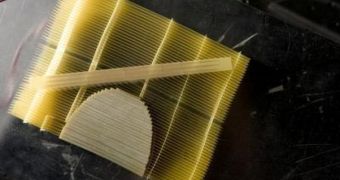Scientists at the Duke University announce the development of a new type of electromagnetic lens that is able to focus wavelengths a lot more clearly than average lenses. The new device doesn't look like a conventional lens and is not made up of a transparent material, such as glass and plastic. The DU team turned to advances in material science to get the things it needed to construct the new instrument. It was only the massive advance that was recorded in metamaterial research that allowed the team to complete its electromagnetic ray handler.
The body of the new lens is made up of a copper-etched fiberglass material, of the same type that can be found inside computer boards. However, the amazing capabilities are only visible when looking at the whole ensemble. It has properties that cannot be readily found in nature, and all of them come in a package that is about four inches by five inches, and less than an inch high. The experts say that it's the arrangement of the individual, parallel plates in the new device that steers the electromagnetic wavelengths passing through it.
“For hundreds of years, lens makers have ground the surfaces of a uniform material in such a way as to sculpt the rays as they pass through the surfaces. While these lenses can focus rays extremely efficiently, they have limitations based on what happens to the rays as they pass through the volume of the lens. Instead of using the surfaces of the lens to control rays, we studied altering the material between the surfaces. If you can control the volume, or bulk, of the lens, you gain much more freedom and control to design a lens to meet specific needs,” DU Pratt School of Engineering postdoctoral associate in electrical and computer engineering Nathan Kundtz says.
Though the new lens was known to be theoretically practical, this is the first time it has actually been practically demonstrated. The work was carried out in the lab of the DU William Bevan Professor of Electrical and Computer Engineering, senior researcher David R. Smith. Details of the investigation appear in an advanced online issue of the prestigious scientific journal Nature Materials. In addition to its capabilities, the new lens also stands out because it has a nearly 180-degree field of view. It can also be used with standard technologies, as its focusing point is flat, the team says.
“While these experiments were conducted in two dimensions, the design should provide a good initial step in developing a three-dimensional lens. The properties of the metamaterials we used should also make it possible to use infrared and optical frequencies,” Smith says. “This first in a new class of lenses offers tantalizing possibilities and opens a whole new application for metamaterials,” he adds.

 14 DAY TRIAL //
14 DAY TRIAL // 
